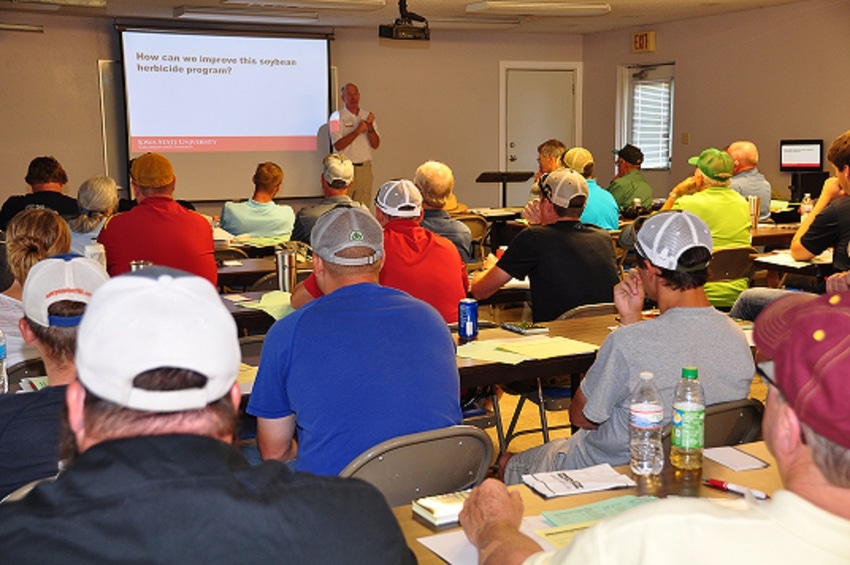September 19, 2016

THINK DIFFERENT
Applying the correct rates of herbicides has become much more complicated with premixes, say Iowa State University weed scientists. Many premixes rely on the additive action of one another, reducing the rates of individual products. ISU recommends analyzing the premix to determine the rate of the individual active ingredients to be applied per acre, comparing that with related single active ingredient products. For effective control, the active ingredient should be applied at 70% or more of the full rate of the single active ingredient product.
--------------------------------------------------------------------------------------
“We’re really failing on rates with herbicides in many cases,” Iowa State University Weed Scientist Bob Hartzler told a group of farmers and retailers at a Weeds Week meeting near Boone in July. While most herbicide programs are put together with multiple herbicide groups (sites of action) and multiple modes of action to deal with resistance, rate problems can arise with premixes.
Many premixes rely on additive action among the individual active ingredients, he said, so rates of individual active ingredients are cut. That means you lose the additive effect if one of the ingredients is not effective on a target weed that has developed resistance, plus the reduced rate of the other active ingredients may not be high enough to be fully effective.
 “The simplest thing we can do to overcome or prevent resistance is to use multiple and effective herbicide groups,” Hartzler told the group. “We’re getting better at using multiple groups, but whether they’re effective is debatable. You need to focus on your problem weeds like waterhemp, and then break down your herbicide program to be sure resistance is being addressed and full rates are being applied.”
“The simplest thing we can do to overcome or prevent resistance is to use multiple and effective herbicide groups,” Hartzler told the group. “We’re getting better at using multiple groups, but whether they’re effective is debatable. You need to focus on your problem weeds like waterhemp, and then break down your herbicide program to be sure resistance is being addressed and full rates are being applied.”
Hartzler recommends four steps to determine whether a program has multiple, effective control for your weeds of concern:
Determine the active ingredient in each product.
Find the herbicide group numbers for the product.
Consult ratings of product effectiveness on target weeds. ISU and others make these ratings. Be sure to consider whether weeds in your fields are resistant to any of the herbicide groups.
Do the math to see if your recommended package will deliver full or near-full rates of the active ingredients.
“While what percentage of the rate is needed to be effective is subjective, we think you ought to shoot for at least 70 percent of the single ingredient full rate.”
Switch when weed control is good
“You need to look at a multi-year approach. I suggest to farmers who have a specific weed program that’s been really good for them the past two to three years, it’s time to change,” said Mark Johnson, ISU Field Agronomist for central Iowa. “Overreliance on a single herbicide group leads to resistance—you should never have just one site of action out there,” Johnson added. “By moving away from a working program, before resistance builds, you can always go back to it again later.”
 Weed specialists refer to modes of action and sites of action (http://bit.ly/HerbModeAction). “Even the ag professionals get these wrong,” Johnson said. “The mode of action is the biological process affected by the herbicide. The site of action is the specific molecule the herbicide binds to. The herbicide group number on herbicide labels refers to the site of action of the active ingredient in the product. The site of action is a subset of mode of action; each herbicide has a site of action herbicide group number assigned to it.”
Weed specialists refer to modes of action and sites of action (http://bit.ly/HerbModeAction). “Even the ag professionals get these wrong,” Johnson said. “The mode of action is the biological process affected by the herbicide. The site of action is the specific molecule the herbicide binds to. The herbicide group number on herbicide labels refers to the site of action of the active ingredient in the product. The site of action is a subset of mode of action; each herbicide has a site of action herbicide group number assigned to it.”
That terminology is important to understand, because just changing from one herbicide to another won’t prevent resistance if they’re in the same group—you have to change to different herbicide groups that don’t have resistance. You prevent resistance by using multiple sites of action, or in other words, multiple herbicide groups that haven’t yet shown resistance.
Resistant weeds in clumps
“If you see clumps of weeds in the field with no spray pattern you can attribute to the weeds, you’re probably seeing the start of resistance,” Johnson said. He and other Extension specialists at the central Iowa meeting in Boone focused on waterhemp. “The biggest weed of concern in Iowa is waterhemp,” said Angie Rieck-Hinz, ISU Field Agronomist for north-central Iowa. “ISU field checks have shown that in general, farmers underestimate how much resistance has developed to herbicides they use,” Rieck-Hinz said. “Waterhemp is resistant to glyphosate, but it’s also resistant to ALS inhibitors (HG2), triazines (HG 5), PPO inhibitors (HG14) and HPPD inhibitors (HG 27). The resistance profile, that is, the herbicide groups a population is resistant to, varies widely from field to field.”
--------------------------------------------------------------------------------------
Premix Weak on Waterhemp?
Weed expert Bob Hartzler compared two premix products as examples and posted his analysis online in an ICM newsletter last January. He noted that active ingredients acetochlor and mesotrione in Resicore have good activity on waterhemp, but the third active ingredient, clopyralid, is weak on waterhemp. However, Resicore is effective on waterhemp used at labeled rates because it still provides two effective herbicide groups (15 and 27) and the rate of active ingredient in their components—acetochlor at 2.1 lb./acre vs. 2.4 lb./acre of standalone product; and mesotrione at .22 lb./acre vs. .24 lb./acre of standalone product—compare favorably with standalone products.
For comparison, a breakdown of SureStart II finds that while three active ingredients are included, only one, acetochlor (15) is effective against waterhemp. Most waterhemp in Iowa is resistant to Group 2 herbicides (including flumetsulam) and again, clopyralid (4) is weak on waterhemp. The rate of active ingredient acetochlor in SureStart II (1.41 lb./acre) is 40% less than the 2.4 lb./acre rate in Surpass, the stand-alone product. The low acetochlor rate reduces the length of residual control, resulting in the postemergence program controlling nearly all of the waterhemp population in fields treated with SureStart II. This is the type of scenario that leads to new resistant biotypes. That’s why Hartzler and others advise farmers to do the math. See a more complete explanation online at http://bit.ly/PremixRates.
Resicore |
|
|
|
|
| ||
Active ingredient (a.i.) | Herbicide Group | lb a.i. /gal Resicore | lb a.i. / A @3 qt Resicore | Stand-alone Product | lb a.i. /A | ||
acetochlor | 15 | 2.80 | 2.10 | 3 pt Surpass | 2.40 | ||
mesotrione | 27 | 0.30 | 0.22 | 7.7 fl oz Callisto | 0.24 | ||
clopyralid | 4 | 0.19 | 0.14 | 0.5 pt Stinger | 0.19 | ||
SureStart II |
|
|
|
|
| ||
Active ingredient (a.i.) | Herbicide Group | lb a.i. /gal SureStart II | lb a.i. / A @3 pt SureStart II | Stand-alone Product | lb a.i. /A | ||
acetochlor | 15 |
| 1.41 | 3 pt Surpass | 2.40 | ||
flumetsulam | 2 | 0.38 | 0.05 | 1.0 oz Python | 0.05 | ||
clopyralid | 4 | 0.12 | 0.14 | 0.5 pt Stinger | 0.19 |
About the Author(s)
You May Also Like




